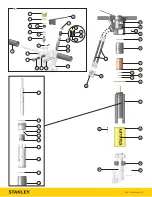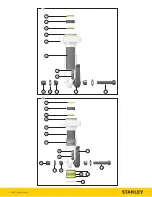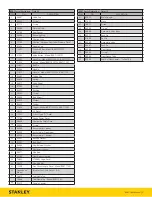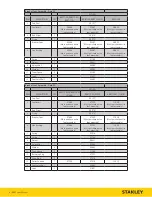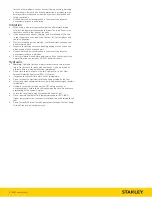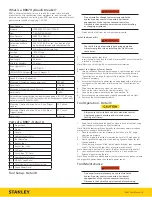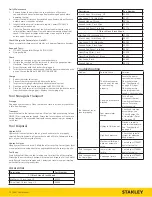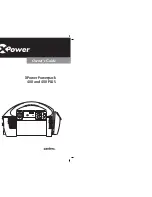
BR87 User Manual | 7
Safety Precautions
The Safety Alert Symbol alerts you to potential
personal injury hazards. Obey all safety messages
that follow to avoid possible injury or death.
Indicates an imminently hazardous situation which
will result in death or serious injury.
Indicates a potentially hazardous situation which
could result in death or serious injury
Indicates a potentially hazardous situation which
could result in property damage.
Always observe safety symbols. They are included for your safety and for the
protection of the tool.
WARNING:
Read all safety warnings and instructions. Failure
to follow the warnings and instructions may result in tool
damage and/or serious injury.
WARNING:
To reduce the risk of injury, read the instruction
manual.
General
•
Do not discard safety instructions. Give to the operator.
•
This tool will provide dependable service if operated in accordance
with the instructions given in this manual. Read and understand this
manual and any stickers and tags attached to the tool and hoses before
operation. Failure to do so could result in personal injury or equipment
damage.
•
Inspect the tool before each use and ensure all decals are legible.
Contact STANLEY if replacements are needed.
•
Establish a training program for all operators to ensure safe operation.
Do not operate the tool unless thoroughly trained or under the
supervision of an instructor. Keep out of the reach of children.
•
Operators and maintenance personnel shall be able to physically handle
the bulk, weight and power of the tool.
•
Avoid unsuitable postures as these positions do not allow for
counteracting of normal or unexpected movement of the tool, such as
a sudden break of the tool bit. Change postures during extended tasks
to help avoid discomfort or fatigue.
•
Never use the tool unless the inserted tool is retained with a proper
retainer.
•
Do not operate a damaged, improperly adjusted, modified or
incompletely assembled tool.
•
Use and maintain the tool as stated in this manual. Misuse of the tool
can cause serious injury. Do not modify the tool in any way.
•
Do not operate the tool in explosive atmospheres, such as in the
presence of flammable liquids, gases or dust. Power tools create sparks
which may ignite the dust or fumes.
•
Provide adequate ventilation in closed areas when operating a gas or
diesel hydraulic power source.
•
Do not inspect, carry, clean, change accessories or perform
maintenance on the tool while the power source is connected.
Accidental engagement of the tool can cause serious injury.
•
Ensure work piece is securely fixed. Be aware that failure of the work
piece or accessories may generate high velocity projectiles.
•
Never use the tool bit as a hand struck tool.
•
Stay alert, watch what you are doing and use common sense when
operating a hydraulic tool. Do not operate this tool if you are tired or
under the influence of drugs or alcohol. A moment of inattention while
operating hydraulic tools may result in serious injury.
•
During operation, do not contact mechanisms, accessories or hardware
as they can become very hot or sharp; use your Personal Protection
Equipment (PPE).
•
Supervising personnel should develop additional precautions relating to
the specific work area and local safety regulations.
•
Never operate the tool if you are unsure about the presence of
underground utilities, such as electrical cables, gas pipes, etc. These can
cause a hazard if damaged with the tool.
•
The tool is not insulated against coming into contact with electric
power. Use hose certified as non-conductive.
•
Do not overreach. Maintain proper footing and balance at all times
when using the tool.
•
Slips, trips and falls are major causes of workplace injury. Be observant
of hoses or oil surfaces lying about the work area, as they can be a
tripping hazard.
•
Operators must start in a work area without bystanders and must assess
the risks to bystanders.
•
Keep work area clean and well lit. Cluttered or dark areas invite
accidents.
•
Operators must be familiar with all prohibited work areas such as
excessive slopes and dangerous terrain conditions.
•
Only use clean hydraulic fluid, filling equipment and lubricants that
have been recommended by STANLEY.
•
Ensure tools are working properly and safely by performing preventative
maintenance (PM) procedures.
•
Repair and service of this tool must only be performed by an authorized
and certified dealer.
•
Do not force the tool to do the work of a larger tool. Use the correct
tool for your application.
•
Use only hoses and hose couplings that are rated for a minimum
working pressure of 2500 PSI (172 BAR).
•
In spite of the application of relevant safety regulations and the
implementation of safety devices, certain residual risks cannot be
avoided. These risks are: repetitive strain injury due to incorrect posture
and risk of pinching fingers when changing tool bit.
Dust and Fumes
•
WARNING:
Some dust created by power sanding, sawing, grinding,
drilling, and other construction activities contains chemicals known
to the State of California to cause cancer, birth defects or other
reproductive harm. Some examples of these chemicals are:
•
Lead from lead-based paints,
•
crystalline silica from bricks and cement and other masonry
products, and
•
arsenic and chromium from chemically-treated lumber.
Your risk from these exposures varies, depending on how often you do this
type of work. To reduce your exposure to these chemicals: work in a well
ventilated area, and work with approved safety equipment, such as those
dust masks that are specially designed to filter out microscopic particles.
Protect yourself and those around you. Research and understand the
materials you are grinding. Follow correct safety procedures and comply
with all applicable national, state or provisional health and safety regulations
relating to them, including, if appropriate arranging for the safe disposal of
the materials by a qualified person.
•
When dust or fumes are created, control them at the point of emission.
Direct tool exhaust to minimize disturbance of dust.
•
Operate and maintain the tool as recommended in this manual to
minimize dust.
•
Use respiratory protection in accordance with employers instruction or
as required by occupational health and safety regulations.
•
Avoid prolonged contact with dust. Allowing dust to get into your
mouth, eyes or lay on the skin may promote absorption of harmful
chemicals.
PPE
•
Always wear safety equipment such as impact resistant goggles, ear
protection, head protection, breathing protection and safety shoes at all
times when operating the tool.
•
Hands may be exposed to hazards, impacts, cuts, abrasions and heat.
Wear gloves.
•
Wear a hardhat if performing overhead work.
•
Use PPE that conforms to standards ANSI Z87.1 (Eye and Face
Protection), ANSI Z89.1 (Head Protection), ANSI Z41.1 (Foot Protection)
and ANSI S12.6 (S3.19) (Hearing Protection).
•
Do not wear loose fitting clothing or jewelry when operating the tool.
M003
Wear Ear
Protection
M004
Wear Eye
Protection
M016
Wear a Mask
Sound
•
Exposure to high noise levels can cause permanent, disabling hearing



